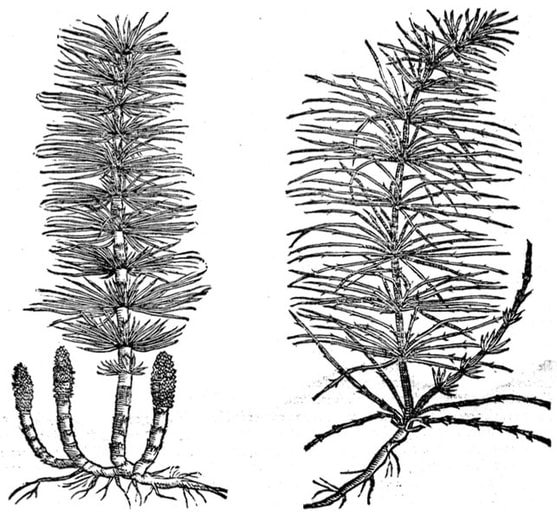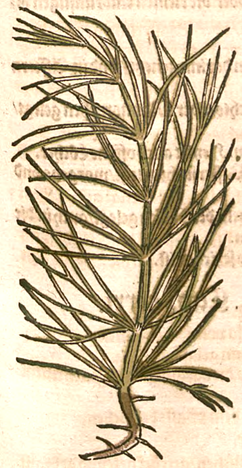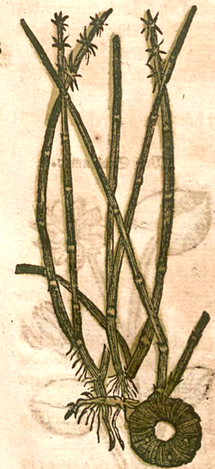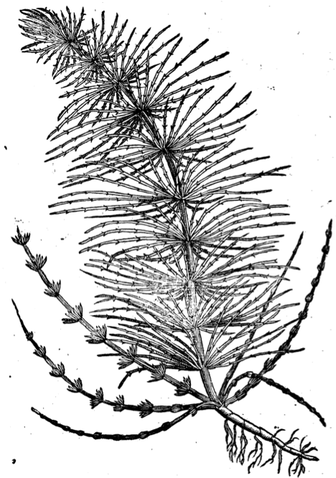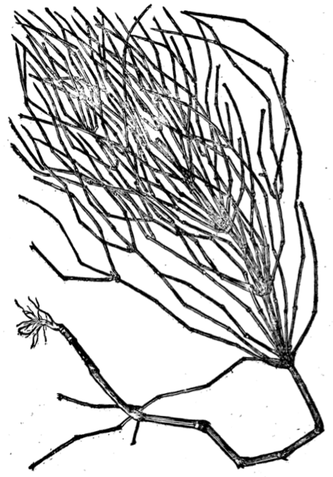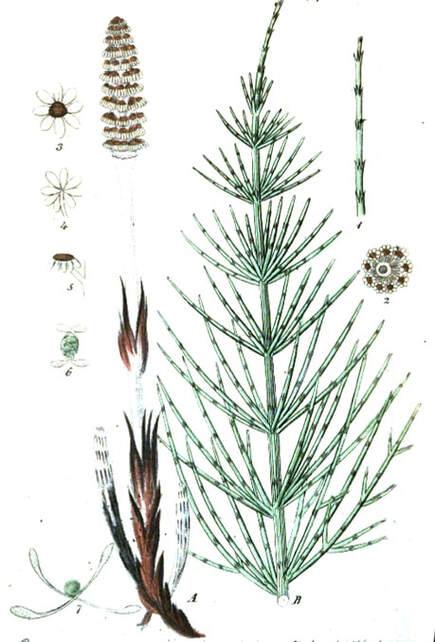Sentry Page Protection
Two varieties of Horsetail
Dioscorides Materia Medica, Mathias, 1563
Dioscorides Materia Medica, Mathias, 1563
Greater Horsetail, the right showing a spindle of wound Horsetail for selling.
Krauterbuch, Lonitzer, 1578
Krauterbuch, Lonitzer, 1578
4 different varieties of Horsetail
New Kreuterbuch, Matthiolus, 1563
New Kreuterbuch, Matthiolus, 1563
E. arvensis
Flora von Deutschland (4), Kohler, 1884
Flora von Deutschland (4), Kohler, 1884
Botanical name:
Equisetum arvense
Also used are E. maximum, E. fluviatile, E. sylvaticum, E. palustre, E. limosum, and E. hyemale, the last being also used in TCM
Parts used:
Herb
Temperature & Taste:
Cool, dry. Salty, sweet.
"It is Cold in the First degree and Dry in the Second degree". (Avicenna)
Classifications:
2N. REPELLENTS. 2O. ASTRINGENTS. 2S. STRENGTHENING. 2T. GLUTINATE. 2Z. CICATRIZING
TCM:
A. Clear Exterior Wind-Heat
Equisetum arvense
Also used are E. maximum, E. fluviatile, E. sylvaticum, E. palustre, E. limosum, and E. hyemale, the last being also used in TCM
Parts used:
Herb
Temperature & Taste:
Cool, dry. Salty, sweet.
"It is Cold in the First degree and Dry in the Second degree". (Avicenna)
Classifications:
2N. REPELLENTS. 2O. ASTRINGENTS. 2S. STRENGTHENING. 2T. GLUTINATE. 2Z. CICATRIZING
TCM:
A. Clear Exterior Wind-Heat
Uses:
1. Clears Heat and Damp, Promotes Urine: (West, Tibet)
-hot, burning Urine; Strangury, Cystitis, Urethritis, Bladder Ulcers
-Acute Prostatitis (BHP specific)
-Gravel, Stones
-Leukorrhea, Vaginitis, Gonorrhea
2. Clears Heat, Stops Bleeding: (West, Tibet, TCM)
-Spitting or Vomiting Blood, or Blood in the Stool or Urine
-applied externally to stop Bleeding
-"it is very useful in cases of Bleeding". (Avicenna)
3. Astringes to Stop Leakage: (West)
-Seminal Emission, Spermatorrhea, Incontinence
-constant desire to Urinate in the Elderly
-Enuresis and Incontinence of Children (BHP specific)
-Excessive Sweating
-"It is astringent specially its extract is extremely desiccant without causing any irritation". (Avicenna)
4. Benefits the Bones and Sinews: (West)
-Lower Back weakness
-Arthritis, Rheumatism, Osteoarthritis
-Fractures
5. Clears Heat, Benefits the Eyes: (TCM)
-red, itchy, bloodshot Eyes
-tearing, Cataracts, Conjunctivitis
6. Clears Heat, Benefits the Lungs: (West)
-dry Cough, Wheezing, shortness of Breath, Hemoptysis
-Lung Ulcers, Tuberculosis, Silicosis
7. Clears Stomach Heat:
-ashes have been used for Indigestion and Stomach acidity
-"useful in inflammations of the Stomach and Liver". (Avicenna)
8. Clears Damp, Resolves Masses:
-Tumors and Cancers of the Abdomen, Intestines, Bones, Liver, Kidney, Stomach and Breast (Duke)
9. Externally:
-good for Wounds, Ulcers, skin Eruptions, as well as Mouth Ulcers etc.
-especially for all poorly healing wounds. ‘Outwardly applied, it cures wounds even when the nerves are cut’. (Pechy)
-The juice or distilled water can be applied to Pustules, and heat-type Swellings of the Genitals in men or women.
-A wash or compress is a valuable application to all types of sores with foul-smelling pus.
-Topically, a strong decoction is used to promote Hair growth, prevent Baldness, and remove Dandruff.
-In Europe it has long been used in baths for various skin diseases
Dose:
In the West, the Juice was regarded as strongest, then the Decoction, lastly the Tincture.
Decoction: 3–9 grams, up to 12 grams
Powder: 500mg–2 grams (up to 4 grams)
Freshly expressed Juice: 10–30mls, taken in water
Tincture (1:5 dried in 25% alcohol): 2–5 mls.
Fluid Extract (1:1): 1–3 mls.
Ashes of Horsetail: 3–10 grains
Distilled Water: 2–3 spoonfuls
In the West, the Juice was regarded as strongest, then the Decoction, lastly the Tincture.
Decoction: 3–9 grams, up to 12 grams
Powder: 500mg–2 grams (up to 4 grams)
Freshly expressed Juice: 10–30mls, taken in water
Tincture (1:5 dried in 25% alcohol): 2–5 mls.
Fluid Extract (1:1): 1–3 mls.
Ashes of Horsetail: 3–10 grains
Distilled Water: 2–3 spoonfuls
Main Combinations:
1. Edema, Horsetail with Juniper berry, Nettle, Rosemary
2. Urinary disorders, difficulty or painful Urination:
i. Horsetail with Yarrow, Cleavers and Couch Grass
ii. Horsetail with Birch, Nettle, Couch grass and Juniper
iii. Difficult Urination, Horsetail with Juniper berry, Parsley seed, Restharrow, Rosehip
3. Gravel, Stones, Horsetail with Knotgrass, Shepherds Purse, Agrimony, Camomile (as in Decoction for Stones)
4. Incontinence, Horsetail with Comfrey, Cyperus rotundus, Plantain, Rue, Agnus Castus, Frankincense (as in Wine for Incontinence)
5. Prostatitis:
i. Horsetail with Willow bark (Ellingwood)
ii. Horsetail with Cleavers, Corn Silk, Kelp, Saw Palmetto (Wonders in Weeds, W. Smith)
6. Ulcers of the Kidney or Bladder, Horsetail with Quince, Sumach, Myrtle berries, Rose and Pomegranate flowers (as in Decoction of Horsetail)
7. 'Hurts of the Bowels and of the Bladder', 4 oz. of the juice of Horsetail with a little Endive juice, or the distilled water of the herb. (The Secrets of Alexis, 1615)
8. Arthritis, Rheumatism, Sciatica, Lumbago, Fractures, Horsetail has been combined with Comfrey
9. Chronic catarrhs of the respiratory and urinary organs, Horsetail with Chickweed, Lance-leaf Plantain, Nettle (Fischer)
10. Trauma to the Tendons or Joints, Horsetail with Nettle and St. Johns wort
11. Internal Wounds and Bleeding, Horsetail with Adder's Tongue
12. Rheumatic pain, Horsetail with Elder flower, Nettle, Dandelion, Birch leaf
13. Consumption, take Horsetail powder with Plantain water.
14. Excess Sweating, Horsetail with Sage
15. Leukorrhea, Horsetail with Ladies Mantle and Dead Nettle (Müller)
16. As a wash for Acne, combine Horsetail with Sage, Camomile and Thyme
17. As a wash for Rashes, combine Horsetail with Camomile, Thyme and Mallow
18. As a wash for Varicose veins, Horsetail with Rosemary, Yarrow, Horse Chestnut
19. As a wash for 'griefs', irritations and swellings of the penis, soak a cloth in Horsetail water and apply regularly. (The Secrets of Alexis, 1615)
20. Dandruff, Make a wash of Nettle, Horsetail and Rosemary
Major Formulas
Infusion for Hernia (Wirtzung)
Decoction for Stones
Wine for Incontinence
Cautions:
1. Not used during Pregnancy
2. Not for frequent Urination or Dryness
3. Toxic in large doses or long-term use
4. Contraindicated in Cardiac or Renal failure.
Toxicity:
–Equisetum arvense (Field Horsetail)-induced liver injury.
–Study of acute hepatotoxicity of Equisetum arvense L. in rats.
Main Preparations used:
Distilled Water
1. Not used during Pregnancy
2. Not for frequent Urination or Dryness
3. Toxic in large doses or long-term use
4. Contraindicated in Cardiac or Renal failure.
Toxicity:
–Equisetum arvense (Field Horsetail)-induced liver injury.
–Study of acute hepatotoxicity of Equisetum arvense L. in rats.
Main Preparations used:
Distilled Water
Click the Tabs above for more information on this Medicine
Pliny on Horsetail:
|
'Equisaetum, a plant called " hippuris" by the Greeks, and which we have mentioned in terms of condemnation, when treating of meadow lands— it being, in fact, a sort of hair of the earth, similar in appearance to horse-hair— is used by runners for the purpose of diminishing the spleen. For this purpose it is boiled down in a new earthen vessel to one third, the vessel being filled to the brim, and the decoction taken in doses of one hemina for three successive days. It is strictly forbidden, however, to eat any food of a greasy nature the day before taking it.
'Among the Greeks there are various opinions in relation to this plant. According to some, who give it the same name of "hippuris," it has leaves like those of the pine tree, and of a swarthy hue; and, if we are to believe them, it is possessed of virtues of such a marvellous nature, that if touched by the patient only, it will arrest haemorrhage. Some authorities call it "hippuris," others, again, "ephedron," and others "anabasis;" and they tell us that it grows near trees, the trunks of which it ascends, and hangs down there from in numerous tufts of black, rush-like hair, much |
like a horse's tail in appearance. The branches, we are told, are thin and articulated, and the leaves, few in number, small, and thin, the seed round, and similar to coriander in appearance, and the root ligneous: it grows, they say, in plantations more particularly.
'This plant is possessed of astringent properties. The juice of it, kept in the nostrils, arrests bleeding therefrom, and it acts astringently upon the bowels. Taken in doses of three cyathi, in sweet wine, it is a cure for dysentery, is an efficient diuretic, and is curative of cough, hardness of breathing, ruptures, and serpiginous affections. For diseases of the intestines and bladder, the leaves are taken in drink; ithas the property, also, of reducing ruptures of the groin. 'The Greek writers describe another hippuris, also, with shorter tufts, softer and whiter. This last, they say, is remarkably good for sciatica, and, applied with vinegar, for wounds, it having the property of stanching the blood.' (The Natural History of Pliny, trans. by Bostock and Riley, Vol. 5, 1856) |



